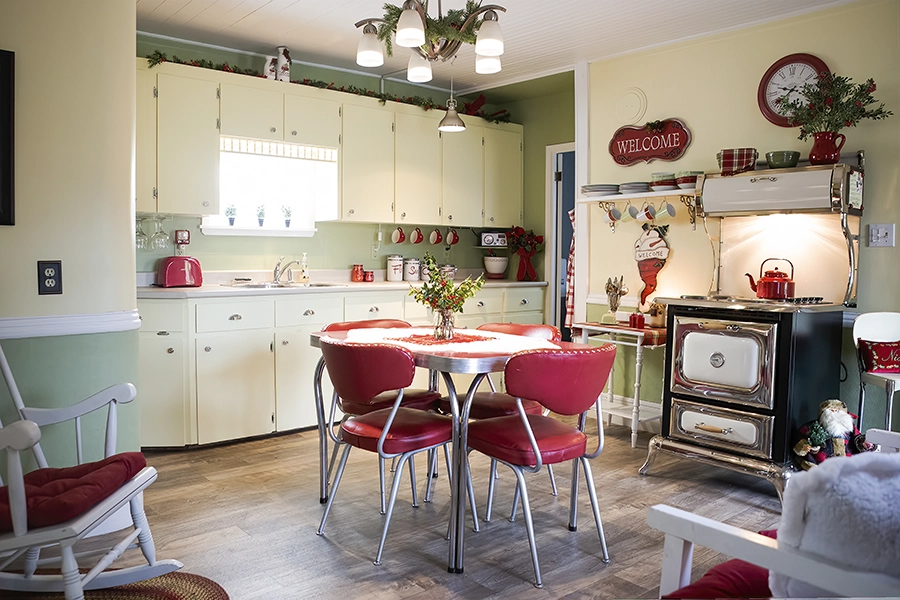No matter the size of your family, everyone eats. And if you’re like most homeowners, the kitchen can quickly become a tornado of books, bags, and other clutter.
“These days we live in our kitchens; it’s the hub of the home where many people spend most of their time and therefore we need room to store a lot of stuff,” says interior designer Holly Costello of Holly Costello Interiors in Corner Brook, N.L. “Aside from the usual kitchen storage, it’s important to consider other day-to-day items such as electronics and chargers, homework supplies, paperwork, recycling, all of which tend to end up in that main area of the house.”
No matter if a homeowner is renovating or building a brandnew kitchen, Costello says they need to ensure there is a designated spot for everything.
One way to do this is by looking at what could or does clutter countertops and cabinets. “We like to incorporate as many pot and pan drawers as humanly possible,” says Charli Junker owner of Your Space Our Design and the Kitchen Design Boutique in St. John’s, N.L.
“We’ve found, over the years, that our clients prefer the use of drawers as opposed to cabinets,” says Junker. “You can fit more in a drawer than you could in a cabinet where you open doors and have adjustable shelving.”
She also likes putting peg boards in drawers, which can be used to hold items like glasses, dishes and mugs. “People with children really like [peg boards] because they can put plastic dishes in there,” says Junker. “And the kids have easy access and can pull the drawers out.”
A pull-out storage solution that Laurie Cole, owner of New View Designs in Fredericton, likes is a blind corner optimizer. Thanks to its design, it can be folded up into existing cabinets and provides more storage space than a lazy Susan or angled cabinet.
“It tucks away in a corner, but you still have easy access to it,” she says.
Cole also recommends storage solutions with more than one purpose. “A cart is a great tool, as you can use it so many different ways: you can have a coffee station on it, you can use it to store bowls, or all of your baking tools on that cart,” she says. “It can be tucked in a corner somewhere or in a pantry.”
Storage areas need to be premeditated. An example Costello gives is when she built drawers into a bench to house art supplies for a client’s children.
“It’s something you wouldn’t assume belongs in a kitchen, but in this case if we hadn’t planned for it and designated storage space, she would go back to having all those items cluttering up her countertops again.”
And, while it is their primary function, walls can be more than room separators. “In my own home, I’ve created a floor to ceiling wine glass cabinet,” says Cole. “It’s right into the wall and people always ask about that when they come in.”
Junker takes a similar approach. She says a lot of people don’t have the space for a walk-in pantry, but that doesn’t mean you can’t build one.
“Let’s say we have a beautiful fridge towards the end of the cabinet run, we’ll incorporate pantry space next to the fridge and have double doors so when you open it you have your floor to ceiling space,” she says. “It’s not a walk-in pantry, but it still has space for cereal boxes and canned goods.”
No matter what kind of features you want, all three designers say it’s important for clients to remember the kitchen is their space and they need to give input to get what will work for them.
“Some people like kitchens that are very neat and minimal, but there are also those clients who like to display the cool kitchen gadgets they have,” says Cole. “It just really depends on their style.”
CONSIDER THESE POINTS BEFORE MEETING WITH A DESIGNER OR CONTRACTOR TO DISCUSS KITCHEN STORAGE
 • List the items you want (or need) to store in the kitchen. This helps your designer plan for things that might not be traditionally stored in that room, like children’s items.
• List the items you want (or need) to store in the kitchen. This helps your designer plan for things that might not be traditionally stored in that room, like children’s items.
• Understand how you use your kitchen: entertainment space, family dining area, mini bakery? For example, if you spend a lot of time cooking for family gatherings you may need more than one oven.
• Consider your mobility and ask for any accommodations that will make navigating your kitchen easier now and in the future.
• Know how many people occupy the room regularly, including pets. Storage is great, but you need to move around too.



















